Celtic Ceramics Reconstructions
Celtic Ceramics of the Hallstatt Era (HaC-HaD1)
deutsche Version
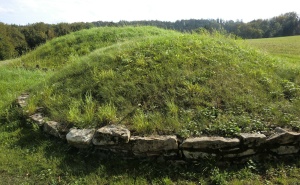 What does that mean? What should one imagine exactly? Mostly, the pieces I show here are not domestic pottery found in settlements (villages/towns). They are rather pieces whitch were discovered in burial mounds – as burial objekts.
What does that mean? What should one imagine exactly? Mostly, the pieces I show here are not domestic pottery found in settlements (villages/towns). They are rather pieces whitch were discovered in burial mounds – as burial objekts.
.
.
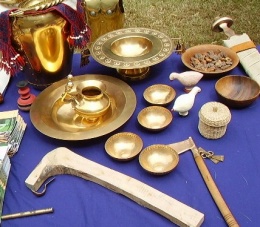 Some of them, a bronze kettle or bronze dishes for instance, might have been in domestic use prior to being buried but graphite-painted pieces of pottery, burnt a very low temperatures, were probably made for the express purpose of being buried together with a deceased person.
Some of them, a bronze kettle or bronze dishes for instance, might have been in domestic use prior to being buried but graphite-painted pieces of pottery, burnt a very low temperatures, were probably made for the express purpose of being buried together with a deceased person.
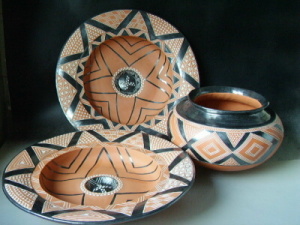 .
.
.
As the Celts left to written records, one can only speculate here. It is a matter of fact, however, that ornaments, shapes, designs or numbers of pieces had a very specific significance. The various vessels are not necessarily urns, as they can also be found at inhumation sites.
Also, „my“ pottery appears during a relatively small period of about 300 years only. The stepped plate, for example, was neither seen bevore that time nor afterwards.
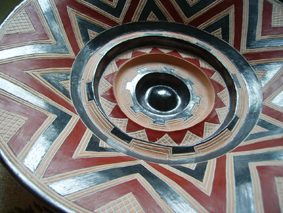
Hence it is believed that the respective burial rite and beliefe must have been very unique during those three centuries and that both were later supplanted by others. The specific pottery shapes were no longer desirable as burial objects and thus disappeared.
In order to better place excavated finds in chronological order, archaeologists use literal abbreviations for increments of 100 or 150 years to designate periods of time. Thus a researcher will immediately know witch period of time he or she is dealing with. The system is useful and, once understood, quite easy to handle. Accordingly, the following periods designate Celtic eras:
Hallstatt Era: HaC (800-600BCE), HaD (600-450BCE)
LaTène Era: LtA (450-400BCE), LtB (400-250BCE), LtC (250-150BCE), etc.
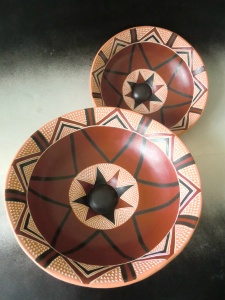 The pottery presented here mostly refers to the HaC and HaD periods. Princely tombs of the Iron Age appear during this epoch and we can actually talk about the first Celts then. I discovered my preference for Württemberg style ceramics from Reutlingen, Alb-Donau, Zollernalb and Sigmaringen countries. But there are other beautiful pieces, of course, stemming from regions in Frankonia and Bavaria.
The pottery presented here mostly refers to the HaC and HaD periods. Princely tombs of the Iron Age appear during this epoch and we can actually talk about the first Celts then. I discovered my preference for Württemberg style ceramics from Reutlingen, Alb-Donau, Zollernalb and Sigmaringen countries. But there are other beautiful pieces, of course, stemming from regions in Frankonia and Bavaria.
Well, I am constantly looking for finds which I find new …
Even though HaC and HaD were relatively short periods of time, vessels, bowls, trays and plates ofthose eras appeared in quite a multifacetted variety of shapes. To give an overview I selected and presented the most expressive shapes varieties of stepped plates or of various types of vessels. Modelling, the stamping, carving, polishing and painting of the vessels always take plenty of time …
To give you an example: It takes 14 steps to complete a stamped and carved ornament, painted graphite-red, true to the original. I always apply patterns freehand. Thus each piece becomes unique and has its own character.
.
These are my main basic shapes of the „stepped“ plate or bowl:
Stepped plates

 diameter: ca. 19-20 cm, height: 4-6-cm
diameter: ca. 19-20 cm, height: 4-6-cm
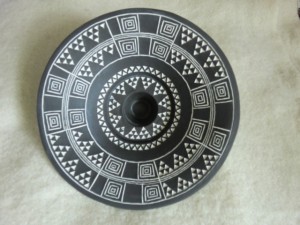
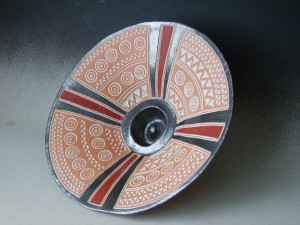
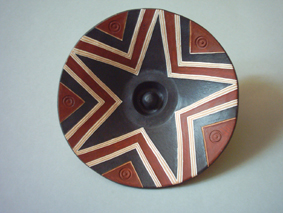
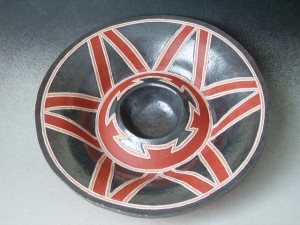
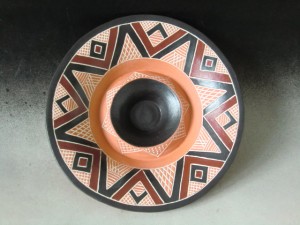
.


 diameter ca. 30-35 cm, height: 6-8 cm
diameter ca. 30-35 cm, height: 6-8 cm
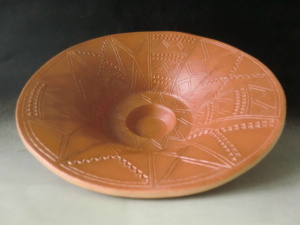
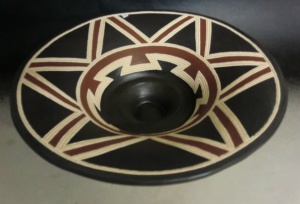
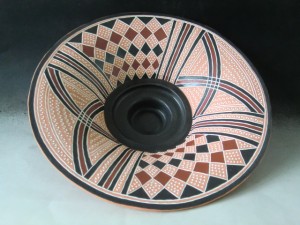
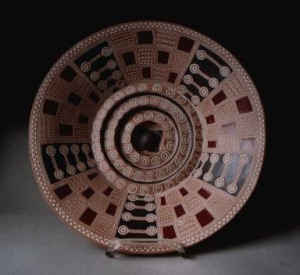
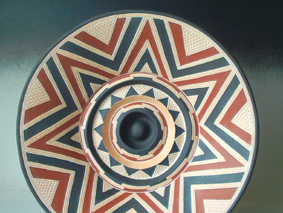
.
Bowls:

diameter: 21cm, height: 4cm 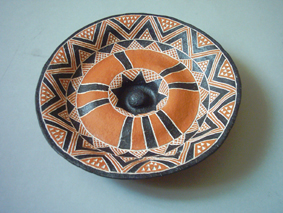
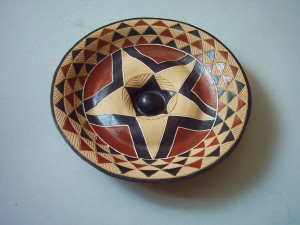
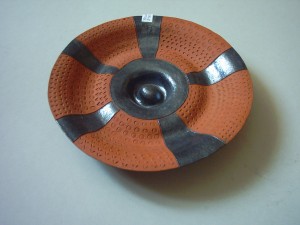
and bigger: 
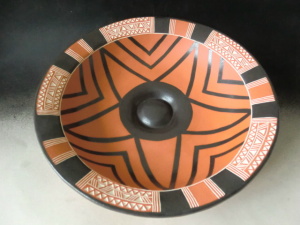
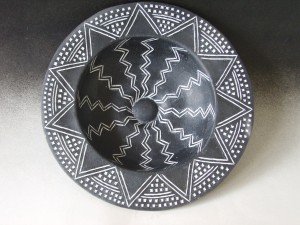 diameter 25-30 cm
diameter 25-30 cm
with stepped bowls 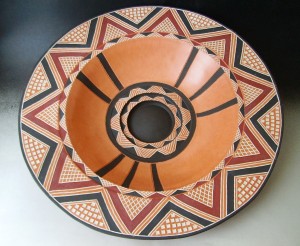 diamter 40 cm
diamter 40 cm
.

diameter: 25cm, height: 7cm 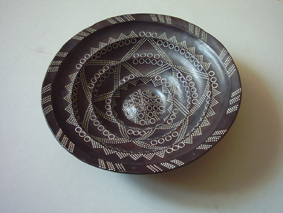 and bigger:
and bigger: 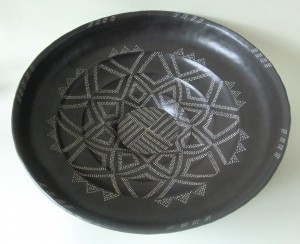 diameter: 45cm, height: ca.12cm
diameter: 45cm, height: ca.12cm
.
Vessel shapes:
here the diameter varies between 15 and 40 cm depending on how big the piece should be. For almost every vessel there is also a bowl variety. Collar-rimmed bowls, for instance, appear in graves quite frequently
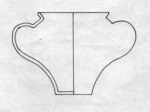
 vessel with cone-shaped rim and round or pointed lid
vessel with cone-shaped rim and round or pointed lid
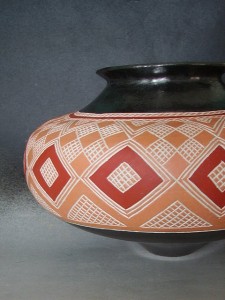
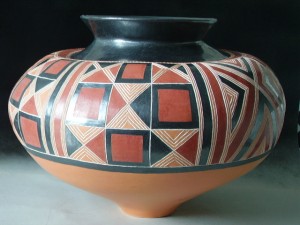
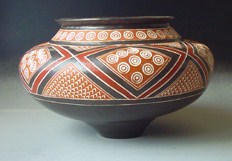
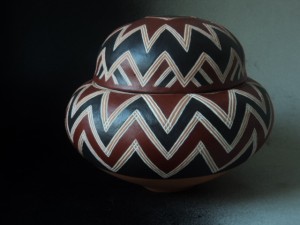
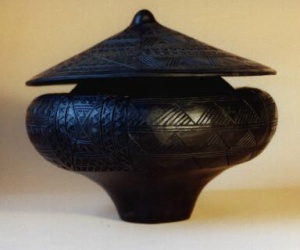
.
 vessel with collar rim
vessel with collar rim
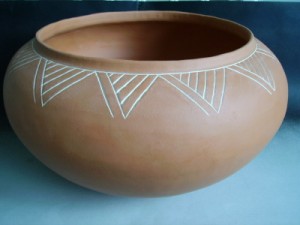
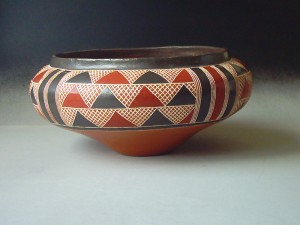
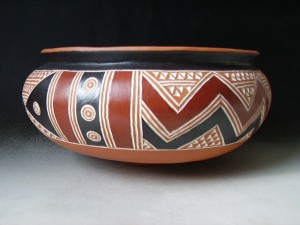
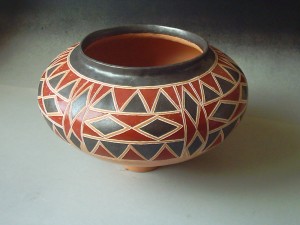
.
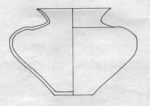 vessel with funnel-shaped rim
vessel with funnel-shaped rim
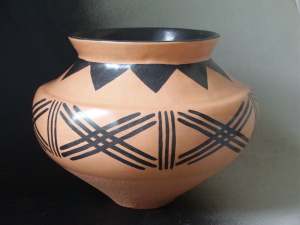
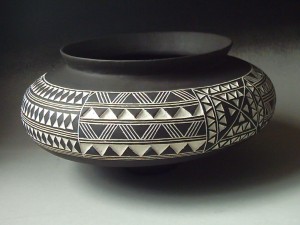
.
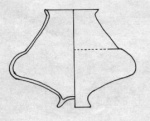
 vessel with tall neck
vessel with tall neck
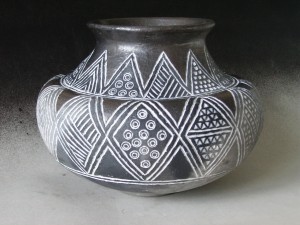
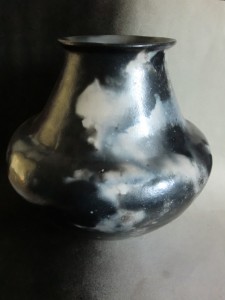
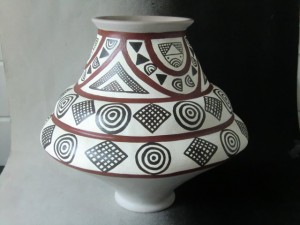
.
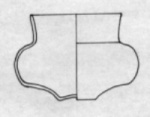 with steep shoulder
with steep shoulder
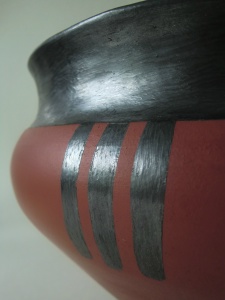
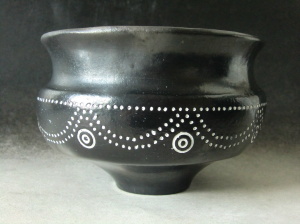 diameter: 15 – 25 cm
diameter: 15 – 25 cm
.
Presently I work with the following colour varieties:
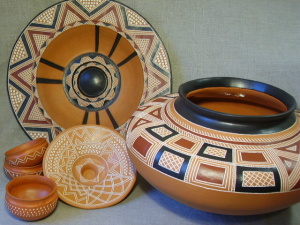 Red ceramics: Clay burning bright or dark red is painted with black or red engobe or graphite. Here I have developed a nice shiny brick-red engobe – similar to Terra Sigillata. Parts of the carved ornaments are white-washed.
Red ceramics: Clay burning bright or dark red is painted with black or red engobe or graphite. Here I have developed a nice shiny brick-red engobe – similar to Terra Sigillata. Parts of the carved ornaments are white-washed.
.
.
.
.
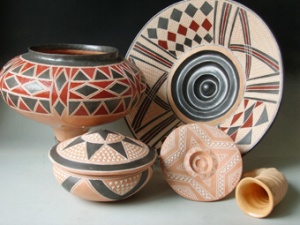 „Coloured“ Alb-Hegau ceramics: Clay burning brown-, leather-, yellow- or anthracite coloured is painted either with white, black or red engobe or with graphite. White lines can be incrusted/white-washed.
„Coloured“ Alb-Hegau ceramics: Clay burning brown-, leather-, yellow- or anthracite coloured is painted either with white, black or red engobe or with graphite. White lines can be incrusted/white-washed.
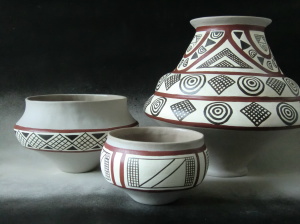
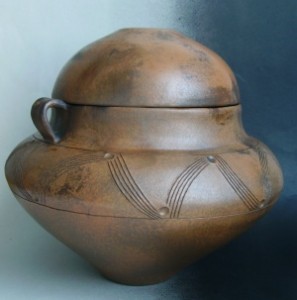
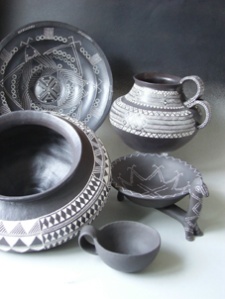 Black ceramics: Original findings, burnt black, were always made in a special firing process, excluding oxygen. Unfortunately pieces produced that way are realy water tight. So I have painted some of my works with jet-black engobe which tends to sinter but which consolidates the pieces at 1050° C. I also work on making pieces in the original reduction firing technology.
Black ceramics: Original findings, burnt black, were always made in a special firing process, excluding oxygen. Unfortunately pieces produced that way are realy water tight. So I have painted some of my works with jet-black engobe which tends to sinter but which consolidates the pieces at 1050° C. I also work on making pieces in the original reduction firing technology.
.
.
.
.
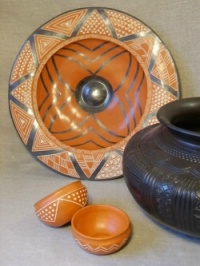 High-gloss ceramics: Special engobes – also called `high-gloss` in archaeologists´ special texts – create high-qualitiy painted surfaces with fine uniform granulation. Such surfaces are quite smooth and shine by themselfs – no final polishing required.
High-gloss ceramics: Special engobes – also called `high-gloss` in archaeologists´ special texts – create high-qualitiy painted surfaces with fine uniform granulation. Such surfaces are quite smooth and shine by themselfs – no final polishing required.